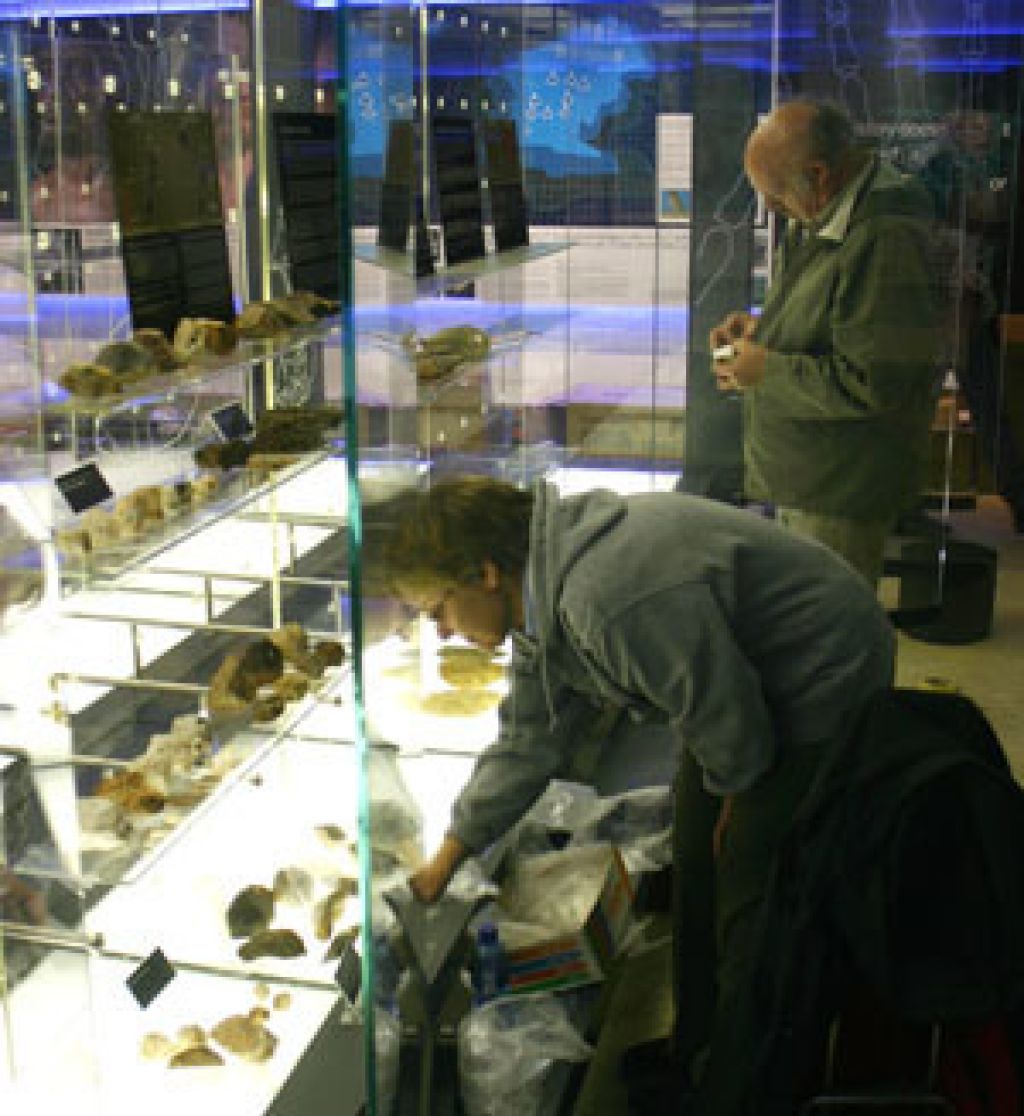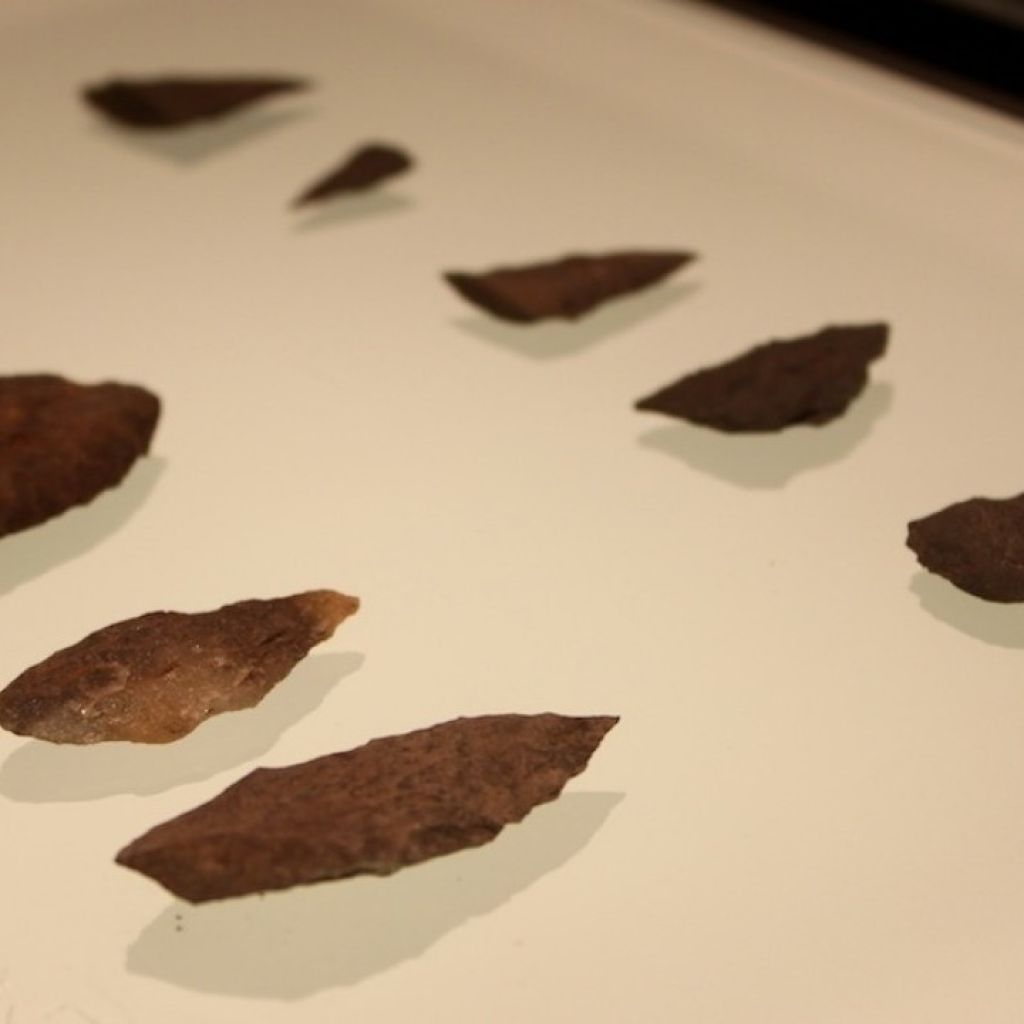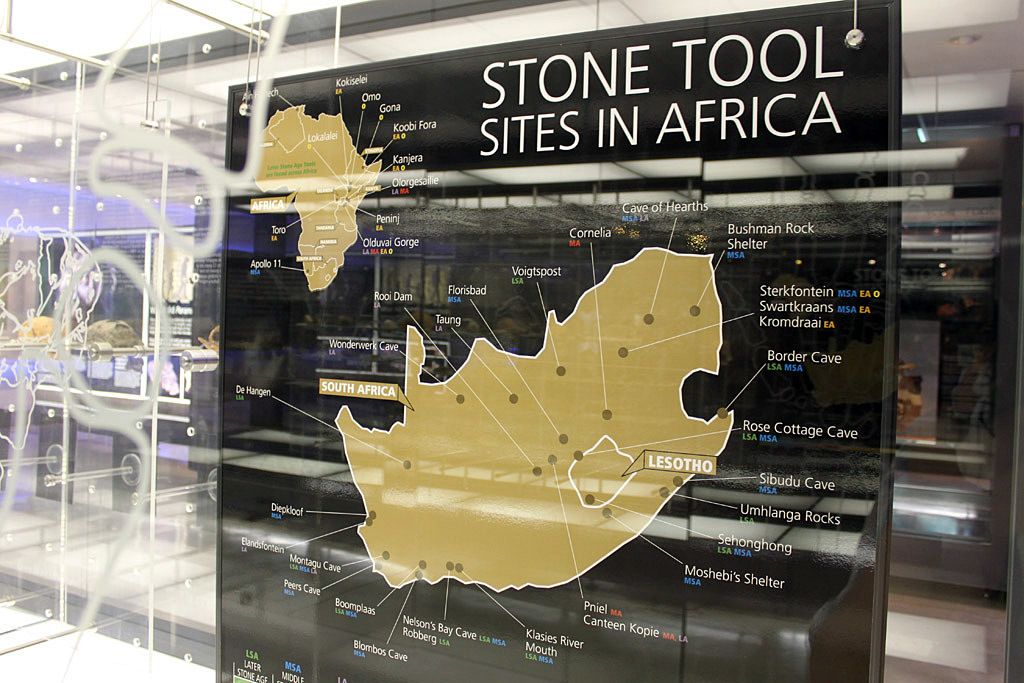Stone tools
One of the features that distinguishes humans and their hominid ancestors from the rest of the animal kingdom is their possession of complex culture, which includes the ability to communicate with spoken language, create art and make tools. The oldest stone tools dated so far are nearly 2.6-million years old and come from Ethiopia.
Our ancestors only began to make more refined tools from bone much more recently, probably only within the last 100,000 years. Bone tools dated to about 80,000 years ago have been found in Blombos Cave, on the southern Cape coast of South Africa.
Some scientists have argued that hominids such as Paranthropus robustus were making bone tools in the Cradle of Humankind far longer ago – perhaps more than 1-million years ago – though this is controversial.
There are two main types of stone tool – those based on flakes chopped off cores of rock, and those made on cores themselves.

The stone flakes, or flake tools, that were struck off the cores, were more usually the desired end-product and were used for cutting and skinning animals or to work plant materials.
Stone cores result from striking flakes of stone off a rock. They are commonly no more than by-products of stone tool making. But some cores could have been used to break open bones for their protein-rich marrow and to chop up tough vegetation for eating. Rocks that weren’t fashioned into stone tools could also have been by hominids for pounding or crushing seeds and for throwing, for example.
Sterkfontein has produced the oldest stone tools in Southern Africa – cores and flakes of the Oldowan industry dating to nearly 2-million years ago.
Oldowan industry or technology
The oldest stone tools and most primitive stone tool technology, the Oldowan industry, is named after Olduvai Gorge in Tanzania, where tools of this type were first discovered.
Sterkfontein has produced the oldest stone tools in Southern Africa – cores and flakes of the Oldowan industry dating to nearly 2-million years ago. These tools were probably made by Homo habilis (“Handy man”).
The manufacture of stone tools marks the first unique trait of the genus Homo. Other primates remain unable to independently create these tools.
An understanding of stone stress factors is required to find the acute angle on the core and give it the sharp, glancing blow required to break off a flake. Chipping flakes off cores is known as “knapping”. Mastering the technique can take days of practice, even for modern humans.
Today, scientists conduct knapping experiments to determine what abilities and techniques are needed to create various stone tools, and to understand the evidence early hominids left behind. By comparison with later industries, the Oldowan is informal, variable and represents the simplest form of stone tool technology. Sometimes, Oldowan tools were creating by simply breaking pebbles.
Fossil handbones from Sterkfontein show that the hand anatomy required to create and use Oldowan tools did not originate with the genus Homo, as even Australopithecus had hands capable of using tools. Rather it was the need to expand their diet and respond flexibly to their environment through cultural adaptations that led our more direct ancestors to invent stone tools.

Oldowan industry (Earlier Stone Age)
Tool Types: The Oldowan industry was the earliest of all stone tool technologies, emerging just after 2.6-million years ago, during the Earlier Stone Age. Simple flakes were the most important tool type. Cores (the rocks off which the flakes are chipped) included those shaped as choppers (flaked along an edge), discoids (flaked to a disk-shape) and polyhedrons (cores with many facets). Some cores could also have been used as tools. Protobifaces from this time were rare core-tools that had been shaped to a point
Age: Approximately 2.6-million years ago to 1.7-million years ago
Raw materials: Quartz, chert, quartzite and various igneous (volcanic) rocks
Who made these tools?Homo habilis and possibly earlier Homo species, preceding Homo habilis
Early Acheulean industry (Earlier Stone Age)
Tool Types: Leading on from the Oldowan, the Early Acheulean saw the appearance of handaxes (shaped to a point) and cleavers (shaped to a sharp, cutting edge). Manuports (rocks carried to a site for future use) occurred in larger numbers than before and showed a greater reliance on using stone for tools. Manuports have been found in East and South African sites (especially at Sterkfontein and Swartkrans).
As in the Oldowan, flakes continued to be the most important tools, but there was now more use of heavy-duty core tools like choppers, handaxes and cleavers. Cores – off which the flakes were chipped for tools – included those shaped as choppers (flaked along an edge); discoids (disk-shaped) and polyhedrons (multi-faceted).
In addition to large numbers of Early Acheulean tools found at Sterkfontein and Swartkrans, other sites in the Cradle of Humankind (Kromdraai, Cooper’s, Goldsmith’s and Drimolen) have produced smaller numbers that probably date from this period.
Raw materials: Quartz, chert, quartzite and various igneous (volcanic) rocks
Who made these tools?Homo ergaster
Acheulean technology
The Early Acheulean industry emerged after the Oldowan and lasted from about 1.7-million years ago to 1-million years ago. This saw the beginning of a long tradition of making handaxes and cleavers. Important was a new ability to strike larger flakes off a core and to use them for making more heavy-duty tools. Acheulean tools were more regular in shape and involved multiple steps in their manufacture, which provides insight into the cognitive development of their makers, Homo ergaster.
Hundreds of early Acheulean cores, flakes and manuports (tools carried from elsewhere), as well as a smaller number of choppers, handaxes and cleavers, have been recovered from Sterkfontein and Cradle of Humankind sites. Such larger, core-based tools were made mainly from quartzite, which flakes in a predictable way.
The name Acheulean comes from a site called St Acheul in France, where Acheulean handaxes were first recognised in the early 1800s, long before Charles Darwin articulated his theory of evolution. The finds created controversy at the time, with many refusing to believe they were made by human ancestors. Some even argued that the handaxes had been created naturally by thunderbolts!
The Early Acheulean lasted from about 1.7-million to 1-million years ago. This was followed by the Middle Acheulean from about 1-million years ago to 600,000 years ago, and the Later Acheulean from about 600,000 years ago to 300,000 years ago.
Acheulean technology remained relatively unchanged for more than a million years, but the apparent lack of progress masks a critical period when Homo ergaster gave way to more evolved species of Homo, such as Homo heidelbergensis and archaic (ancient) Homo sapiens. Acheulean technology was carried out of Africa to Europe and as far east as India.
Middle Acheulean industry (Earlier Stone Age)
Tools: The Middle Acheulean period, which lasted from about 1-million years ago to 600,000 years ago, saw greater standardisation of handaxe technology and the manufacture of better-made handaxes and more cleavers. Flakes were now more often “retouched”, or lightly flaked around their edges in order to re-sharpen them or to create a type of working edge.
Core types in the Middle Acheulean were similar to those in the previous Oldowan and Early Acheulean industries.
Age: 1-million years ago to 600,000 years ago
Raw Materials: Quartz, chert, quartzite and various igneous (volcanic) rocks
Who made these tools? Possibly an unknown Homo species, more evolved than Homo ergaster, as represented by hominid fossils from Bodo (Ethopia), Buia (Eritrea), Olorgesailie (Kenya) and Ndutu (Tanzania)
Later Acheulean (Earlier Stone Age)
Tools: The Later Acheulean industry, which occurred after 600,000 years ago in the Earlier Stone Age, saw a greater standardisation of handaxe technology, requiring a high degree of competence from the toolmakers. The Later Acheulean also saw an increase in the amount of “prepared cores” which were used to create flakes of predetermined size and shape for specific tasks.
By about 300,000 years ago, there were important changes among hominids, who were by now physically similar to modern humans. During this period, transitional tool traditions emerged, such as the Fauresmith and Sangoan industries, marking the progression from the Earlier Stone Age to the Middle Stone Age. The Fauresmith industry was concentrated in areas of grassland and was typified by small, elegant tools, which were probably used for butchery.
The Sangoan industry is associated with more wooden habitats. Sangoan tools were larger and heavier than Fauresmith tools and were probably used for woodwork. By 300,000 years ago, hafted tools – tools stuck into wood and bone, sometimes with resin and bound with thongs – first appeared.
Age: Approximately 600,000 years ago to 300,000 years ago.
Raw materials: Quartz, quartzite, various igneous rocks, chert, silcretes, hornfels.
Who made these tools? Archaic (near modern) Homo sapiens, sometimes called Homo heidelbergensis.
Middle and Later Stone Age: smaller, finer tools
The development of a new stone flaking technique, the Levallois technique, is associated with the Middle Stone Age (roughly 280,000 to 40,000 years ago in Southern Africa) and with the progression toward modern Homo sapiens. The Levallois technique allowed our ancestors to create many flakes of predetermined size and shape by carefully preparing the core first.
The production of these standardised flakes is associated with the first hafting of stone tools into handles and shafts (composite tools such as clubs). Middle Stone Age hominids abandoned the use of heavy core-tools when they invented a more lightweight, mobile toolkit. In South Africa, composite tools were widely used in some regions between 80,000 and 60,000 years ago, though they first appeared in Zambia about 300,000 years ago.
By about 40,000 years ago, humans had learned to craft small flakes and blades for their composite tools – such as the tips of spears. These small, slender stone tools are known as microliths. The development of these tools was the final major advancement in stone technology. They allowed humans to design tools for an ever greater variety of specific tasks.
Stone was replaced by copper, bronze and tin in tool-making as more complex societies arose about 5000 years ago. This Bronze Age was followed by an Iron Age. In sub-Saharan Africa, the Iron Age succeeded the Stone Age directly, about 2000 years ago.
Though the use of stone tool technology has mostly died out, there is still knowledge of it in some communities, and among the San in Southern Africa it continued well into the colonial era.

Middle and Later Stone Age: smaller, finer tools
The development of a new stone flaking technique, the Levallois technique, is associated with the Middle Stone Age (roughly 280,000 to 40,000 years ago in Southern Africa) and with the progression toward modern Homo sapiens. The Levallois technique allowed our ancestors to create many flakes of predetermined size and shape by carefully preparing the core first.
The production of these standardised flakes is associated with the first hafting of stone tools into handles and shafts (composite tools such as clubs). Middle Stone Age hominids abandoned the use of heavy core-tools when they invented a more lightweight, mobile toolkit. In South Africa, composite tools were widely used in some regions between 80,000 and 60,000 years ago, though they first appeared in Zambia about 300,000 years ago.
By about 40,000 years ago, humans had learned to craft small flakes and blades for their composite tools – such as the tips of spears. These small, slender stone tools are known as microliths. The development of these tools was the final major advancement in stone technology. They allowed humans to design tools for an ever greater variety of specific tasks.
Stone was replaced by copper, bronze and tin in tool-making as more complex societies arose about 5000 years ago. This Bronze Age was followed by an Iron Age. In sub-Saharan Africa, the Iron Age succeeded the Stone Age directly, about 2000 years ago.
Though the use of stone tool technology has mostly died out, there is still knowledge of it in some communities, and among the San in Southern Africa it continued well into the colonial era.
Middle Stone Age (MSA)
Tools: Prepared core technologies were now widely used and composite toolkits (such as tools bound or “hafted” to pieces of wood as spears) become common. Tools included triangular flakes; blades; denticulates (tools retouched to a serated edge); retouched points and scrapers. Hafted tools included backed pieces (segments and trapezoids) in some regions and some periods (backing is the blunting of one edge of a tool at an approximately 90º angle to aid in the mounting of stone in hafts). Segments are shaped like the segment of an orange, while trapezoids have four sides, two of which are parallel. Occasional grindstones occurred (flat stone blocks with a shallow depression, used for processing hard items like seeds). Rare bone points are also found from this period.
Age: Approximately 300,000 to 40,000 years ago
Raw materials: Fine-grained raw materials such as silcretes and agates, quartz, quartzite, chert, hornfels and basalt
Who made these tools? Archaic and modern Homo sapiens
Later Stone Age (LSA)
Tools: The Later Stone Age saw the emergence of microlithic (tiny) tool types including adzes (for cutting wood); scrapers; blades; segments; trapezoids; points; backed tools; plus grindstones, and bored stones (used as digging stick weights)
Age: From 40,000 years ago to historical times
Raw materials: Fine-grained raw materials such as silcretes, agates and obsidian, as well as quartz, quartzite, chert, and hornfels
Who made these tools? Modern humans (Homo sapiens)